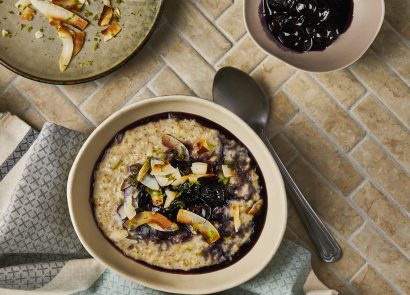-
Strength train The problem with runners is they tend to ‘just run’, but making time for resistance work is actually key. “If you’re looking to improve your time over a specific distance then get in the gym and hit the weights for the lower body”, says Mark Wood, training manager at British Military Fitness (britmilfit.com). “The speed at which you run is heavily influenced by your ability to apply force into the ground. To run faster, you need to apply more force – this means strength. The best way to do this is to strengthen the lower body. Focus on building muscle in the thighs, calves and glutes, using bodyweight exercises such as lunges and squats.”
-
Wear correct footwear PT Steve Hoyles (hoylesfitness.com) tells us, “Having your gait (running style) analysed professionally will help to make sure you pick the perfect shoe for your technique.” Nowadays, this can be done in most reputable running shops. Steve explains the importance: “By wearing the right shoes, you dramatically reduce injury risk and will improve your running speed and efficiency.” Usually recorded whilst you run on a treadmill, the expert fitters should match you with a shoe which will have you instantly running better, more comfortably and with reduced risk.
-
Find your rhythm Get in the correct pace for you and you’ll be rewarded with greater stamina, fitness instructor Jan Smith (jansmithfitness.co.uk) says. “Warm up by walking for two minutes and jogging for two minutes. Concentrate purely on getting your breathing right. You should be breathing in long breaths through your nose and out through your mouth – maximum oxygen in, maximum oxygen out. Establish a rhythm in your footsteps. Breathe in for four steps and out for four steps.” This approach will set your breathing rhythm up for the rest of your run.
-
Fuel up Remember, you’re about to burn significantly more calories than your body is used to. “Getting your eating habits right will help massively”, says Mark Wood, advising, “balance your diet to include good quality protein to help repair and rebuild your working muscles, and seasonal fruits and vegetables to boost your immune system and help deal with the stresses your body goes through when running.”
-
Don’t overload on carbs “Too many carbs the night before will weigh heavily on you, making you sluggish and slower when you run,” says Steve Hoyles. This is all because digestion diverts more blood to the digestive tract – blood that could be used to transport oxygen to your muscles as you run. The advice? Steve tells us, “I typically advise clients to stick to clean, natural carbs such as rice, and suggest two heaped handfuls in a serving the night before a run.”
-
Good posture Running tall can help to keep injury away, as well as making for an easier run. Cecilia Harris, consultant at Results With Lucy (resultswithlucy.com) says that your running technique is totally dependent on your posture. “The efficiency of your running technique is directly proportional to the quality of your posture. Along with many other mainstream body movement disciplines, good posture for running involves having a reasonably straight spine with not too much bend. The more you slump, the more your body’s muscles need to work to hold you upright.”
-
Relax Tensing up around the back, shoulders, neck and jaw can heavily impact your breathing and uses extra and unnecessary energy, making you fatigue far quicker. Steve Hoyles advises, “Maintain relaxation in your mindset, and throughout your body, making breathing easier thanks to an open chest. Staying relaxed requires much less energy than a tight, tense runner would need as there is a lot less muscular contraction taking place.”
-
Find a running buddy “Accountability is the most important quality in any type of fitness partner, but especially in a running partner”, says Cecilia Harris, “Your ideal running partner needs to be someone who won’t take your excuses for why you can’t run, or why you want to run less than planned.” Cecilia tells us having a partner can be a massive motivational factor for commitment. “It’s the best way to never miss a run and also makes the run more fun as you have company and conversation.”
-
Interval training Put simply, interval training is one of the best exercises for improving speed. “Interval training in the fitness industry is known for its benefits in improving fitness levels quickly, which is great news for busy people who don’t want to spend two hours on each training session,” says Cecilia Harris. “Runners need to be able to run faster for longer periods of time and this is where interval training aids them. It improves fitness levels and therefore aids an endurance-based exercise such as running, as a runner learns to alternate between bouts of fast-paced running with slower-paced running known as recovery.” The stop and start nature of interval training encourages the body to recover quickly and the muscles to work more efficiently at faster/higher speeds. “This, over time, will increase your ability to run faster for longer”.
-
Include rest days This one is surprisingly the most challenging of all for the super-keen. Endorphin levels and the feeling of all-round wellbeing achieved from running mean that we just want to do it! “Rest and recovery are a vital part of training”, says Mark Wood. However, this doesn’t mean we become couch potatoes on these days. It’s actually good to keep the body moving, but just not through running. “Get your body used to some easier movement”, says Mark. “Start the day with some stretching exercises and repeat throughout the day. Stay active, keep moving, but lower the intensity significantly.”
Show your inbox some love
Get a weekly digest of Health & Wellbeing emailed direct to you.




















